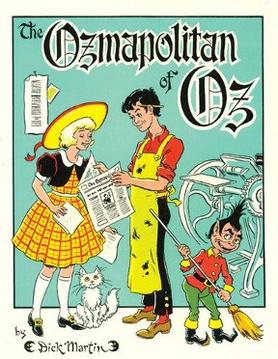The Ozmapolitan of Oz facts for kids

First edition
|
|
| Author | Dick Martin |
|---|---|
| Illustrator | Dick Martin |
| Country | United States |
| Language | English |
| Series | The Oz Books |
| Genre | Fantasy |
| Publisher | International Wizard of Oz Club |
|
Publication date
|
1986 |
| Media type | |
| Pages | 104 pp. |
| Preceded by | The Forbidden Fountain of Oz |
| Followed by | The Wicked Witch of Oz |
The Ozmapolitan of Oz is a fantasy novel published in 1986. It was written and illustrated by Dick Martin. This book is part of the well-known Oz series of stories. These tales are set in the magical Land of Oz, first created by L. Frank Baum and continued by many other writers.
Contents
About the Author
Dick Martin was famous for drawing pictures for Oz books before he started writing them. The Ozmapolitan of Oz is his only full-length Oz novel. Because he was both the writer and the artist, Martin had complete control over how his story looked and felt.
Most Oz authors create a young human character for readers to connect with. Martin did this too, but he made his main character a teenager, a fifteen-year-old boy. In his drawings, Martin also made Dorothy Gale look a bit older than she usually does, appearing at least twelve years old.
The Name "Ozmapolitan"
The word "Ozmopolitan" was first used in 1904. It appeared in advertisements created by Baum's publisher, Reilly & Britton. The idea was that the Wizard of Oz started a newspaper with this name. Dick Martin used this same idea for his novel.
Reilly & Britton sent out news releases that looked like this Oz newspaper in 1904 and 1905. They did this to promote Baum's book The Marvelous Land of Oz. Later, the publisher used "Ozmapolitan" for other books, including Merry Go Round in Oz, which Dick Martin illustrated. Even today, some fan magazines about Oz use this name.
The Story of the Ozmapolitan
The main character is Septimius Septentrion, who works as a printer for the Ozmapolitan newspaper in the Emerald City of Oz. One day, he meets Princess Dorothy. They come up with a plan to find exciting news for the quiet Oz newspaper.
Septimius, along with a small creature named Jinx and Dorothy's cat Eureka, starts a journey across the Winkie Country. Their first goal is to meet the Scarecrow at his corn-shaped house. But things quickly go wrong!
Along the way, they meet a fortune-teller. They get mysterious predictions from gingerbread fortune cookies:
- Dorothy's fortune is "A Fat Chance."
- Septimius's is "A Blue Moon."
- Jinx's is "A Silent Melody."
As they travel through an Art Colony, a Game Preserve, and a long underground journey, they learn what these fortunes mean. They meet strange creatures and see unusual things, like a Trade Wind and a dragon-like Tyrannicus Terrificus.
They also rescue a frozen water spirit named Melody, who is a cousin of the rainbow fairy Polychrome. Melody later saves them from the dragon.
After getting lost in caves for a long time, the group finally meets the Scarecrow and his friend the Tin Woodman. They are sailing in the Scarecrow's new boat, which is called the Blue Moon. Everyone returns to the Emerald City with lots of exciting stories for the Ozmapolitan newspaper. During their adventure, Septimius's secret royal family background is also revealed.
The idea of the Scarecrow and Tin Woodman sailing boats comes from an earlier story called "The Scarecrow and the Tin Woodman," published in 1913–14.
The Art Colony Adventure
Since Dick Martin was an artist, his description of the Art Colony in Chapter Six is very interesting. Dorothy and her friends have their pictures painted by living paintbrushes. But the portraits are very strange and distorted. For example, Jinx gets a cubist portrait, which looks like it's made of geometric shapes.
The travelers are shocked to find that they have magically changed to look like their strange portraits! Dorothy's picture makes her look "willowy" and "boneless," and suddenly she has "elongated arms and snaky fingers." Septimius becomes "a lumpy, bow-legged clown with green skin, purple hair, and mismatched ears." Dorothy exclaims, "We're victims of a Modern Art movement!"
They can only return to their normal forms with magical help from a fat man named Chance. Martin likely wrote this to entertain young readers. However, his story suggests he wasn't a big fan of some modern art styles.

